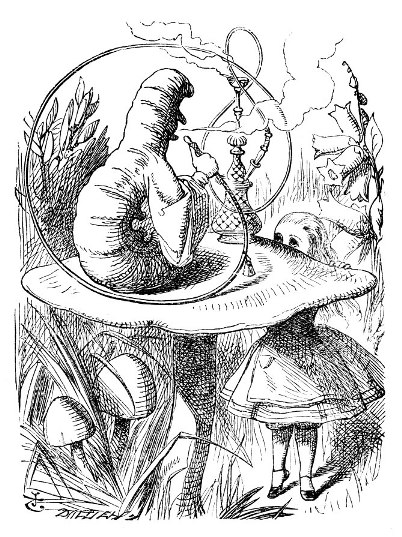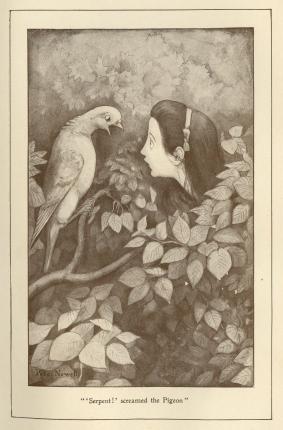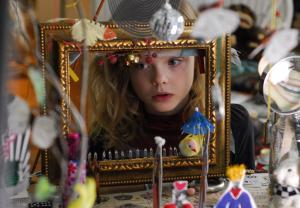Serendip is an independent site partnering with faculty at multiple colleges and universities around the world. Happy exploring!
Serpent! Serpent!


"'...I know who I was when I got up this morning, but I think I must have been changed several times since then.'
"'What do you mean by that?' said the Caterpillar, sternly. 'Explain yourself!'
"'I can't explain myself, I'm afraid, Sir,' said Alice, 'because I'm not myself, you see.'"
--Lewis Carroll, Alice in Wonderland
identity: 2. a. The sameness of a person or thing at all times or in all circumstances; the condition or fact that a person or thing is itself and not something else; individuality, personality.
personal identity (in Psychology), the condition or fact of remaining the same person throughout the various phases of existence; continuity of the personality.
--the Oxford English Dictionary
 Within Alice’s Adventures in Wonderland, the idea of “sameness…in all circumstances” is as absurd as any nonsense poem the story contains. When Alice is an egg-eating creature tall enough to access a bird’s nest in its tree, she is a serpent; when she is among talking Lions and Unicorns she is a fabulous monster. Likewise, the things and people around her maintain no stable identity; flamingos and hedgehogs are used to play croquet, cats appear without their bodies and grins without their cats, and words mean whatever their speakers decide they do. By the end of Through the Looking Glass, Alice is sufficiently unsure of what is her and what is not to wonder whose dream she has just been a part of. Carroll offers no answer, only the option to "pretend [not to have heard] the question." In a world where people and things can be defined only by their attributes, Carroll suggests, there is no continuity of identity.
Within Alice’s Adventures in Wonderland, the idea of “sameness…in all circumstances” is as absurd as any nonsense poem the story contains. When Alice is an egg-eating creature tall enough to access a bird’s nest in its tree, she is a serpent; when she is among talking Lions and Unicorns she is a fabulous monster. Likewise, the things and people around her maintain no stable identity; flamingos and hedgehogs are used to play croquet, cats appear without their bodies and grins without their cats, and words mean whatever their speakers decide they do. By the end of Through the Looking Glass, Alice is sufficiently unsure of what is her and what is not to wonder whose dream she has just been a part of. Carroll offers no answer, only the option to "pretend [not to have heard] the question." In a world where people and things can be defined only by their attributes, Carroll suggests, there is no continuity of identity.
Phoebe in Wonderland explores a similar issue: if a person is the sum of their thoughts and actions, what do we do when we cannot control either of these—which, the movie suggests, is often, even if most people do not experience it to the same extreme that Phoebe does? At the same time that Phoebe does not separate her actions from her identity, she identifies a “voice in [her] head,” part of her but not her, that causes them.
Alice and Phoebe’s struggles with identity seem to suggest a similar problem as does Andy Clark's idea of the "soft self": that of the failure of one’s tools. Clark suggests that the human “self” is composed of a "control-sharing coalition of processes" and tools, including the brain and extending out to any tool or process a human uses to accomplish a task; what are the implications of these tools being fallible and incomple tely controllable? Alice’s tools for understanding the universe and herself (words, and her established self-definitions) fail her, leaving her without certainty that she is “[her]self and not something else”; Phoebe loses control over the tools and processes that define her, which likewise complicates her understanding of who she is and where her self exists, if she cannot explain or control it. The characters surrounding Alice and Phoebe struggle with these limitations as well: the adults around Phoebe grapple with accidental rule-breaking that "just slips out" like Phoebe's does; the language failure Alice experiences in her dream world points out the precariousness of meanings assigned in her waking life.
tely controllable? Alice’s tools for understanding the universe and herself (words, and her established self-definitions) fail her, leaving her without certainty that she is “[her]self and not something else”; Phoebe loses control over the tools and processes that define her, which likewise complicates her understanding of who she is and where her self exists, if she cannot explain or control it. The characters surrounding Alice and Phoebe struggle with these limitations as well: the adults around Phoebe grapple with accidental rule-breaking that "just slips out" like Phoebe's does; the language failure Alice experiences in her dream world points out the precariousness of meanings assigned in her waking life.
Both versions of the Alice story, then, suggest the difficulty of pinning down a stable self-identity that is separate from the faulty and fluctuating systems in which it resides. Phoebe, however, seems to have less trouble accepting this idea than do the original Alice books, which present the question of identity as an unsolved one (and possibly also a source of sadness, given the poems at either end of each book that lament the passing of childhood). Once Phoebe has a name for her difference, she can accept it as part of herself without it making her "less." Perhaps this solution flows logically from the idea of a self composed of one's aspects; thinking of Tourette's as a facet of Phoebe's identity may be the only possible option if she is composed entirely of her tools and processes. Phoebe is no more separate from the thing that "makes [her] break rules" than she is from the rest of her brain, or her performance as Alice, or (according to Clark) the pen and pencil she uses to do math problems.
By Phoebe's logic, the fact of her Tourette's is inherently no more troubling than Clark perceives the integration of technology into human biological systems. Since human functionality and identity are always fluctuating, and always fallible, Phoebe's "difference" does not make her inherently different or "less." As Clark rejects the idea of advancing technology birthing a new breed of human, based in the idea that all human technological development is based in the same concept, Phoebe rejects the idea that her lack of control over her identity differentiates her especially from those around her.
![]() Alice and Phoebe seem to challenge an individual's ability to control their identity or their actions. If things and people are composed of tools and processes that are faulty and unpredictable, one of which is the dangerously precarious (and often ridiculous) set of collectively agreed-upon names and norms that is their only method of assigning meaning to each other, how then should we define ourselves? We are not always (if ever) able to control our own behaviors (even when we perceive ourselves making choices of our own free will, were those choices not made more likely by the combination of characteristics of which we are composed and which we did not choose?), and we certainly have little control over the collective meaning that is assigned to us. Both Alice and Phoebe seem to seek to shake their audiences into awareness of the fragility of our systems of identity, possibly with a nudge towards the deconstruction of these systems. What do we install in their place?
Alice and Phoebe seem to challenge an individual's ability to control their identity or their actions. If things and people are composed of tools and processes that are faulty and unpredictable, one of which is the dangerously precarious (and often ridiculous) set of collectively agreed-upon names and norms that is their only method of assigning meaning to each other, how then should we define ourselves? We are not always (if ever) able to control our own behaviors (even when we perceive ourselves making choices of our own free will, were those choices not made more likely by the combination of characteristics of which we are composed and which we did not choose?), and we certainly have little control over the collective meaning that is assigned to us. Both Alice and Phoebe seem to seek to shake their audiences into awareness of the fragility of our systems of identity, possibly with a nudge towards the deconstruction of these systems. What do we install in their place?



Comments
Unpredictability as a feature, not a bug...
jrf--
you do a lovely job, here, of building on the paper you wrote last month, about Andy Clark's idea of our "soft selves," to begin nibbling away @ one of the deepest (and to me most interesting) aspects of the Alice stories: the ways in which they highlight the difficulty (as you say) "of pinning down a stable self-identity that is separate from the faulty and fluctuating systems in which it resides." Your move from dictionary definitions of identity as "sameness," "continuity" and "integrity" to the representation of "human functionality and identity as always fluctuating, and always fallible" is a striking and convincing one, as is the further move to question the usefulness (and damaging effects) of our using a "dangerously precarious (and often ridiculous) set of collectively agreed-upon names and norms that is our only method of assigning meaning to each other."
You end by asking what we should install in the place of such habits. One way to go on thinking about this might be to reconsider (and stop using!) the language of "uncontrollable," of "less," of "fallible," of "faulty." Mightn't we re-think our social structures not as Cultures of Disability but rather as Cultures of Ability?
Another way to go on with your thinking might be to study the ways in which a particular portion of the population, those we call transgender, are re-thinking -- and re-sculpting -- the self: focusing less on the "fragility of our systems of identity" and more on their revisability. Unpredictability becomes then not a bug, but a feature, of self-fashioning. For a starting bibliography, see
Arthur Robinson Williams. “My Right Self.”
Bernice Hausman. “Introduction: Transsexualism, Technology, and the Idea of Gender” and “Epilogue.” Changing Sex: Transsexualism, Technology and the Idea of Gender. Durham, North Carolina: Duke University, 1995. 1-19, 195-200.
Sandy Stone. "The Empire Strikes Back: A Posttranssexual Manifesto,” Sex/Machine: Readings in Culture, Gender, and Technology. Ed. Patrick Hopkins. Indiana University Press, 1998. 322-341.
Reprinted in The Transgender Studies Reader. Ed. Susan Stryker and Stephen Whittle.
New York: Routledge, 2006:
Suzanne J. Kessler and Wendy McKenna, "Toward a Theory of Gender" (1978): 165-182.
Judith Butler, "Doing Justice to Someone: Sex Reassignment and Allegories of Transsexuality" (2001): 183-193.
Kate Bornstein, "Gender Terror, Gender Rage" (1994): 236-243.
Susan Stryker, "My Words to Victor Frankenstein Above the Village of Chamounix -- Performing Transgender Rage." (1994): 244-256.
Patrick Califia, "Manliness." 434-438.